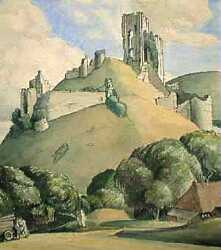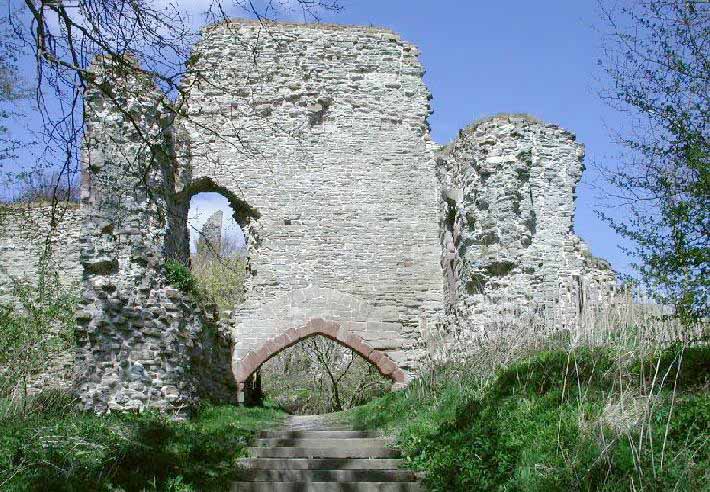Mortimer Family
Mortimer is one of a handful names, which became hereditary in the eleventh century. The first to be so called, Roger, was seigneur of the castle and township of Mortemer sur Eaulne, a place situated on a hill which had at some point been surrounded by an ox-bow lake of the River Eaulne. This stagnant water (the name means 'dead sea' or 'dead pool') around the town gave the place - and the family - its name. (It may be romantic to think, as the Victorians did, that the name was brought to England by a returning crusader who had visited the shores of the Dead Sea...)
In 1054 there was an important battle at Mortemer, known afterwards as the battle of Mortemer
en Brai. Roger found himself fighting for his lord, Duke William of Normandy, against an army of
Frenchmen. Unfortunately for Roger, he had previously sworn allegiance to one of
the Duke's prisoners, the Count of Montdidier, who was entrusted to his custody. By feudal law and
the oaths he had sworn Roger was bound to release him. When Duke William found out that Ralph de
Montdidier had been set free he was justifiably angry. The lordship of Mortemer was confiscated
and given to Roger's relation, Ralph de Warrenne. ....
more

Corfe castle, where Roger Mortimer imprisoned King Edward II
- A1. Roger, Sn de Mortemer-sur-Eulne, lvd:1054;
- B1. Ralph de Mortimer, lvd:1066/1104;
- C1. Hugh de Mortimer;
- D1. Hugh de Mortimer, Lord of Wigmore, lvd:1108/1181, m. Maud de Meschines;
- E1. Roger de Mortimer, Lord of Wigmore, m. Isabel de Ferrieres;
==> Ferrers family
- F1. Joanne de Mortimer, m. Walcheline de Beauchamp; ==> Beauchamp family
- F2. Ralph de Mortimer, lvd:1190/1246, m. Gwaldys Verch Llewelyn;
==> Princes of Wales
- G1. Sir Roger de Mortimer, lvd:1231/1282, m. Maud de Braose;
==> Braose family
- H1. Isabella de Mortimer, m. Sir John FitzAlan; <== FitzAlan family
- H2. Sir Edmund de Mortimer, Lord of Wigmore, d:1304, m. Margaret de Fiennes;
==> Fiennes family
<=========
- G1. Sir Roger de Mortimer, lvd:1231/1282, m. Maud de Braose;
==> Braose family
- E1. Roger de Mortimer, Lord of Wigmore, m. Isabel de Ferrieres;
==> Ferrers family
- D1. Hugh de Mortimer, Lord of Wigmore, lvd:1108/1181, m. Maud de Meschines;
- C1. Hugh de Mortimer;
- I1. Isolda Mortimer, m. Hugh de Audley; <== Audley family
- I2. Sir Roger Mortimer, 1st Earl of March, d:1287/1330, m. Joane de Geneville;
==> Geneville family
- J1. Margaret Mortimer, m. Sir Thomas de Berkeley; ==> Berkeley family
- J2. Catharine Mortimer, m. Thomas de Beauchamp; ==> Beauchamp family
- J3. Sir Roger Mortimer, m. Joane Butler;
==> Butler family
- K1. Janet Mortimer, m. Sir Andrew Gray; <== Gray Clan
- J4. Sir Edmund, Lord Mortimer, lvd:1305/1332, m. Elizabeth Badlesmere;
- K1. Roger Mortimer, 2nd Earl of March, d:1359, m. Philippa de Montacute;
==> Montacute family
- L1. Edmund Mortimer, 3rd Earl of March, lvd:1352/1381, m. Philippa Plantagenet;
==> Plantagenet
- M1. Elizabeth Mortimer, lvd:1371/1417, m. Sir Henry 'Hotspur' Percy; <== Percy family
- M2. Roger Mortimer, 4th Earl of March, lvd:1374/1398, m. Alianore Holand;
==> Holand family
- N1. Anne Mortimer, lvd:1400, m. Richard Plantagenet of Conisburgh; <== Plantagenet
- M3. Edmund Mortimer, d:1409, m. Catrin Glendower;
- N1. Bernard Mortimer of Craigievar;
- O1. Isabel Mortimer, m. Sir Andrew Leslie; <== Leslie family
- N1. Bernard Mortimer of Craigievar;
- L1. Edmund Mortimer, 3rd Earl of March, lvd:1352/1381, m. Philippa Plantagenet;
==> Plantagenet
- K1. Roger Mortimer, 2nd Earl of March, d:1359, m. Philippa de Montacute;
==> Montacute family
- B1. Ralph de Mortimer, lvd:1066/1104;
